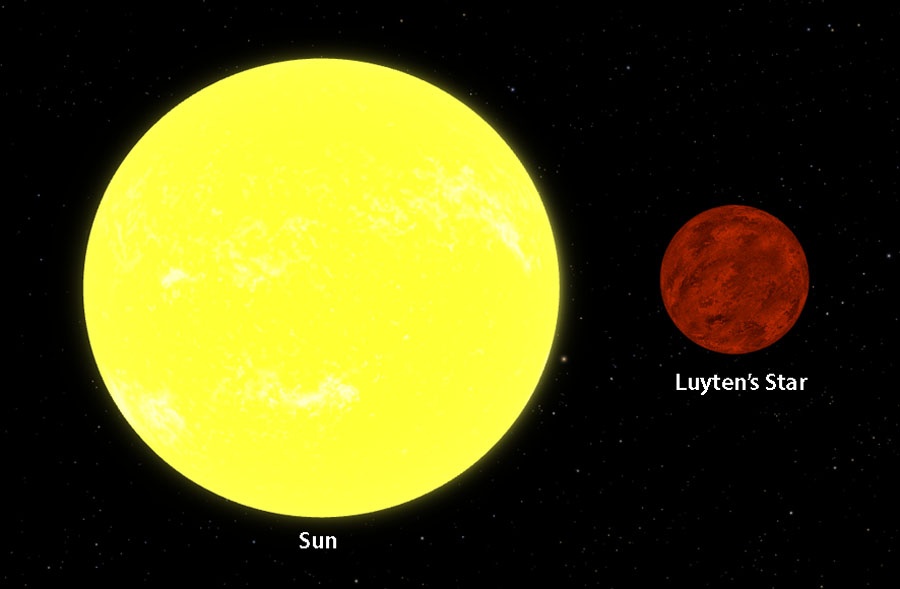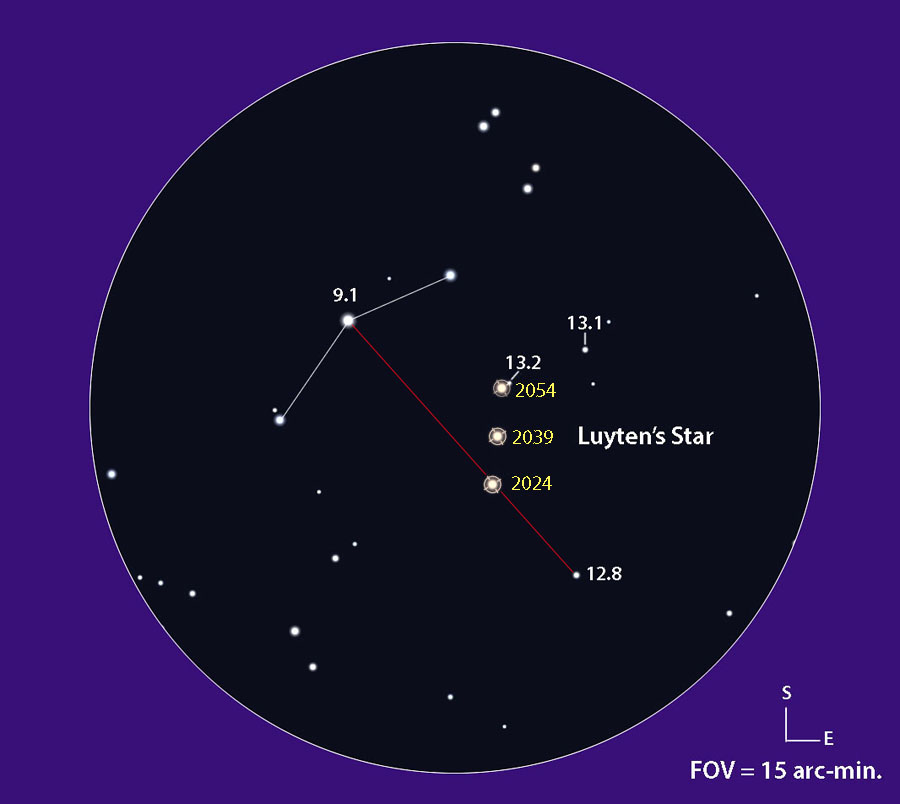Relish the slow, steady pace of nearby Luyten’s Star then switch things up with speedy meteors from a well-timed shower.

NASA / JPL
Watching stars move of their own accord rather than ferried around the sky by Earth's rotation and revolution makes for a yearslong observing project. Perfect for procrastinators like me. Stars lie at such vast distances it takes at least a year and often much longer to detect their creep across the background of more distant suns. Barnard's Star, a nearby red dwarf in Ophiuchus, is the fastest of them with an actual motion through space — called proper motion — amounting to 10.4 arcseconds per year according to the latest Gaia data. Depending on its proximity to field stars and the making and breaking of distinctive alignments with other stars as it pushes northward, it's possible to detect the dwarf's intrinsic motion in as little as a year.
Edmund Halley is often credited with being the first to discover proper motion by comparing star positions recorded by the ancient Greek astronomer Hipparchus (circa 150 BC) with modern values. Recent research suggests that his measurements may have been spurious and instead attributes the French astronomer Jacques Cassini with the honor. Cassini used precision positions made by Tycho Brahe almost a century and a half earlier to detect Arcturus's slight southerly drift in 1738. (See page 30 in the June 2022 issue of Sky & Telescope for more on the discovery of proper motion.)

Stellarium with additions by Bob King
Each season offers one or more stars with proper motions large enough for amateurs to track in a telescope. This winter put Luyten's Star on your list. The start of a new year is an ideal time to begin your relationship with this shy luminary because the celebrated date serves as an easy reminder of when to check back. Located a hair under 3° due west of Procyon and 12.3 light-years from Earth, the red dwarf has an annual motion of 3.7″ to the southeast. At magnitude 9.9 even a 60-mm telescope will show it, while larger instruments will reveal the star's reddish hue.

I started at Procyon and star-hopped past the target to a bright, 7.0-magnitude star that forms an obtuse triangle with 7.8- and 8.8-magnitude stars. From here it was a quick, 20′-side-trip back east to Luyten's Star. In my 10-inch Dob I could faintly detect the dwarf's color. Ideally you want your target star to lie close to another star — one neither too bright nor too faint — to make motion-detection obvious in as short a time as possible, say one year. Barring that I try to find stars the target will line up with to form a straight line (an easy mark for human vision) or a current straight-line pattern that will break in the years ahead.

Stellarium with additions by
Bob King
Among possible alignments to check its progress I found the relatively easy one shown in the map above. Of course, much depends on the magnitude limit of your telescope. The fainter the stars you can see — and the higher the magnification — the more potential make-and-break patterns become available. Based on its current location I suspect I'll see its crawl in 3 years. Lucky you if you'll be around in the early 2050s when its close passage of a 13th-magnitude star may make movement obvious in just a year or two.
With the unaided eye the stars stay stuck in their appointed positions over many lifetimes. To see even one on the run gives us a visceral feel for how far they are. Witnessing their tiny shifts we can more deeply sense the galaxy as a thriving, active community of stars going about their business like so many bees in a hive. And it's so easy! Make an initial observation, note the position in a sketch, map or photo, and then return a couple years later. Hey, no hurry.

NASA / JPL
But Luyten's Star offers more than lessons in galactic anatomy. Two confirmed exoplanets orbit the ruddy coal — GJ 273b, a super-Earth 2.9 times as massive as our own planet located along the inner edge of the star's habitable zone, and GJ 273c, an Earth-size body orbiting closer in. The latter is 1.2 times as massive as the Earth and one of the lightest exoplanets detected using the radial velocity method. Procyon lies a bit more than a light-year away from the system and shines as brightly as Venus (magnitude –4.5) in the skies of both planets.
Let's hope someone's home on GJ 273b. In 2017 and 2018, scientists used the EISCAT (European Incoherent Scatter Scientific Association) radio antenna in Tromsø, Norway, to beam an eclectic mix of music created by contemporary composers associated with the European Sónar music festival to the potentially habitable world. The batch of more than thirty 10-second-long musical miniatures are expected to arrive in the year 2030. Assuming a quick response, a return message could make it back to Earth in about 2042.
The Sónar group conceived of the idea — dubbed Sónar Calling GJ 273 b — to celebrate the festival's 25th anniversary by sending music to a potential exoplanet audience that would complete the round trip in 25 years. The music bits made for fascinating listening, and the videos of the musicians talking to the camera were fun and thought-provoking. Check out a selection of both along with an informative FAQ.
Quads on target

Bob King
Good news for the annual Quadrantid meteor shower if you live in North America. The predicted peak of this brief but intense meteor shower occurs around 9:00 UT (4 a.m. EST) on January 4th according to the International Meteor Organization. Fortuitous timing puts the radiant moderately high in the eastern sky at shower maximum. Rates can top 100 per hour under ideal circumstances when observed from a rural, moonless sky with the radiant near the zenith at peak viewing time.

The only piece of bad news is that the last-quarter Moon will shine from Virgo, reducing the meteor count by perhaps half. It's also possible that the timing may be slightly variable — the American Meteor Society has maximum occurring from 9:00 to 15:00 UT (4 to 10 a.m. EST). But with prospects looking very good overall I encourage you to reserve at least an hour between 1 a.m. and dawn local time on Thursday, January 4th. Face north with the Moon at your back for the best view.
 0
0









Comments
You must be logged in to post a comment.